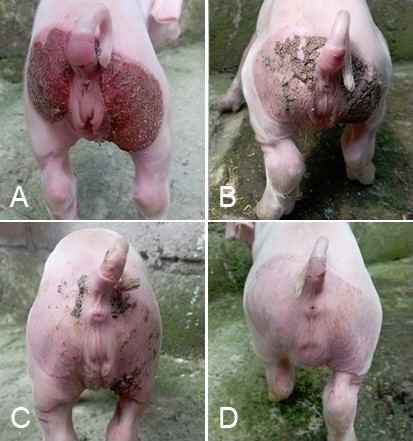Epitheliogenesis imperfecta in a day-old Landrace piglet in Payangan, Gianyar, Bali
Abstract
One of the six Landrace piglets was born without skin on their thighs. Physical examination showed that the piglets had a birth weight of 1.32 kg, temperature of 39.1oC, absence of skin on the back of the right (4.2 × 7.1 cm) and left (5.1 × 5.3 cm) thighs and the base of the tail, and open wounds. Based on signalment, case history, and physical examination, the piglets were diagnosed with epitheliogenesis imperfecta (EI). The therapy administered was procaine antibiotics and benzathine penicillin G at a dose of 1 ml/10 kg body weight (BW) once injection. Diphenhydramine HCl at a dose of 1 mg/kg BW was given once. Wound cleansing was performed daily with 0.9% NaCl infusion solution, and a 10% povidone-iodine antiseptic was administered for 14 days. The wound was left open without dressing. On the 3rd day after birth, piglets were supplemented with Ferdex® Plus at 2 ml/piglet once. Piglets were left with their sows during the treatment. Treatment results showed healing starting from the formation of a scab on day three and slowly sloughing off until day 8 (remaining ± 10% of the scab). The skin had fully grown, and the wound had completely healed by day 15 after the piglets were born.
Downloads
References
Benoit-Biancamano MO, Drolet R, D'Allaire S. 2006. Aplasia cutis congenita (epitheliogenesis imperfecta) in swine: observations from a large breeding herd. Journal of Veterinary Diagnostic Investigation. 18(6):573-579. https://doi.org/10.1177/104063870601800608 | PMid:17121085
Girish BC, Shilpa VT, Shivakumar MC, Ravikumar P. 2023. Pathology of epitheliogenesis imperfecta in two herds of pigs. Indian Journal of Veterinary Pathology. 47(4):345-347. https://doi.org/10.5958/0973-970X.2023.00061.5
Kuemmet TJ, Miller JJ, Michalik D, Lew SM, Maheshwari M, Humphrey SR. 2020. Low risk of clinically significant central nervous system dysraphism in a cohort study of 69 patients with isolated aplasia cutis congenita of the head. Pediatric Dermatology. 37(3):455-460. https://doi.org/10.1111/pde.14117 | PMid:32053222
Ogunro BN, Otuh PI, Olatunji-Akioye A, Emikpe BO, Oyebanji V, Adejumobi O, Morenikeji O. 2016. Management of epitheliogenesis imperfecta in a piglet (Sus scrofa domesticus) in Ibadan, Nigeria. Nigerian Veterinary Journal. 37(3):187-191.
Radhakrishnan R, Sundaram SM, Gnanaraj PT. 2024. A case of nonsyndromic aplasia cutis congenita (epitheliogenesis imperfecta) in a Large White Yorkshire piglet. International Journal of Veterinary Sciences and Animal Husbandry. 9(4):04-05. https://doi.org/10.22271/veterinary.2024.v9.i4Sa.1509
Zhou F, Wang S, Qin H, Zeng H, Ye J, Yang J, Cai G, Wu Z, Zhang, Z. 2023. Genome-wide association analysis unveils candidate genes and loci associated with aplasia cutis congenita in pigs. BMC genomics. 24(1):701. https://doi.org/10.1186/s12864-023-09803-6 | PMid:37990155 PMCid:PMC10664689

Copyright (c) 2025 CC-BY-SA

This work is licensed under a Creative Commons Attribution-ShareAlike 4.0 International License.
Authors who publish with this journal agree to the following terms:
1. Authors retain copyright and grant the journal right of first publication with the work simultaneously licensed under a Creative Commons Attribution License that allows others to share the work with an acknowledgement of the work's authorship and initial publication in this journal.
2. Authors are able to enter into separate, additional contractual arrangements for the non-exclusive distribution of the journal's published version of the work (e.g., post it to an institutional repository or publish it in a book), with an acknowledgement of its initial publication in this journal.
3. Authors are permitted and encouraged to post their work online (e.g., in institutional repositories or on their website) prior to and during the submission process, as it can lead to productive exchanges, as well as earlier and greater citation of published work (See The Effect of Open Access).

.jpg)















